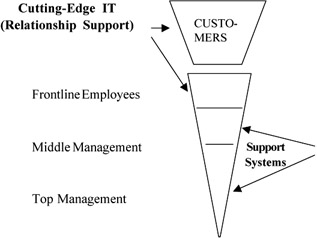Current Issues with CRM in Business
|
| < Day Day Up > |
|
Technology Issues
These include inconsistent or missing data, legacy systems, channel proliferation, cost, lack of in-house skills and change management.
Legal Issues
Almost every time a decision is made, there exists the possibility of legal repercussions. If the decision incorporates a characteristic that is not allowed by law, there might be problems. Over the past decade, a number of financial service companies have been fined because of improper selection techniques for the marketing of credit cards and other types of loans. Historically, the term "red lining" has been used to describe the process of excluding people who live in particular areas from receiving credit or other financial services. These exclusions often occurred because of the racial makeup of the excluded neighborhoods (Anderson, 2000, p. 377). When using data mining techniques in support of CRM activities, it may be prudent to do a post-mining analysis to determine whether any of the patterns found by the data mining system disproportionately affected a protected class. This would involve simple statistical profiling of each protected class to evaluate whether the predictive model has excluded any protected groups (Anderson, 2000, p. 378).
Communication-Related Issues
While company-controlled information (such as a company web site, e-mail services, etc.) can be strategically used to customize communication with regard to customer needs, customer-controlled communication may threaten relationship marketing success. Disaffected customers can use information platforms on the Internet to spread the word about their negative experiences. This can have a detrimental impact on the relationships with existing and prospective customers.
Implementation Issues
Companies making the transition toward technology-enabled relationship marketing must keep several implementation issues in mind. First, significant early-mover advantages will accrue to companies that make the transition sooner than later. Each new generation of technologies builds upon the learning curves associated with the previous generation. Although it is possible in some cases to leapfrog generations of technology, this happens only when there is revolutionary change. When technology changes in a more evolutionary (albeit still rapid) manner, early adoption is crucial. Rather than wait for the perfect moment to enter, companies need to jump in and start deploying the new technologies as early as possible. They need to accumulate institutional experience with the technology and develop the ability to customize it to suit their purposes. Early-mover advantages tend to persist for a long time, provided that the company keeps abreast of rapid technological changes. When a business gets redefined around customer relationships and when the process of managing those relationships gets thoroughly reengineered, companies need to make significant changes in how they organize their activities. First, they must define the entire business in service terms. They must greatly elevate the role in customer retention and thus profitability. Both customer service (retention) and sales (customer acquisition) must report to the marketing function. The company should also enable self-service by developing easy-to-use customer-focused tools (Iacobucci & Ostrom, 1995, pp. 558-559).
A vital component of success in this arena is the provision of cutting-edge information technology to sales, customer service, and other frontline personnel. Companies that are most successful achieving dramatic impacts through information technology are those that deploy it at the front lines, where it can directly affect customer satisfaction; refer to Figure 2 (Iacobucci & Ostrom, 1995, pp. 559-560).

Figure 2: Frontline information systems (FIS) for relationship marketing (Iacobucci & Ostrom, 1995, p. 559)
Enterprises that purchase CRM solutions that are not flexible, scalable, and extensible and that do not integrate their operations will ultimately be unable to respond to competitive pressure and will fail (Boudette, 2000, p. 44). Seamlessly integrating the front and back office in today's organizations that are large with each business unit having its own complex set of systems, applications and hardware platforms brings the issue of connectivity and seamless integration to the forefront. Customization will always be required and as solutions get bigger and more complex the amount of customization will grow (Boudette, 2000, p. 49).
|
| < Day Day Up > |
|
EAN: 2147483647
Pages: 174
- ERP System Acquisition: A Process Model and Results From an Austrian Survey
- Enterprise Application Integration: New Solutions for a Solved Problem or a Challenging Research Field?
- Distributed Data Warehouse for Geo-spatial Services
- Data Mining for Business Process Reengineering
- Healthcare Information: From Administrative to Practice Databases